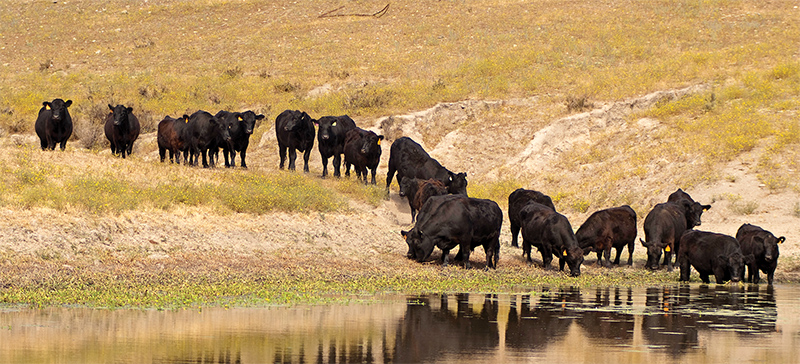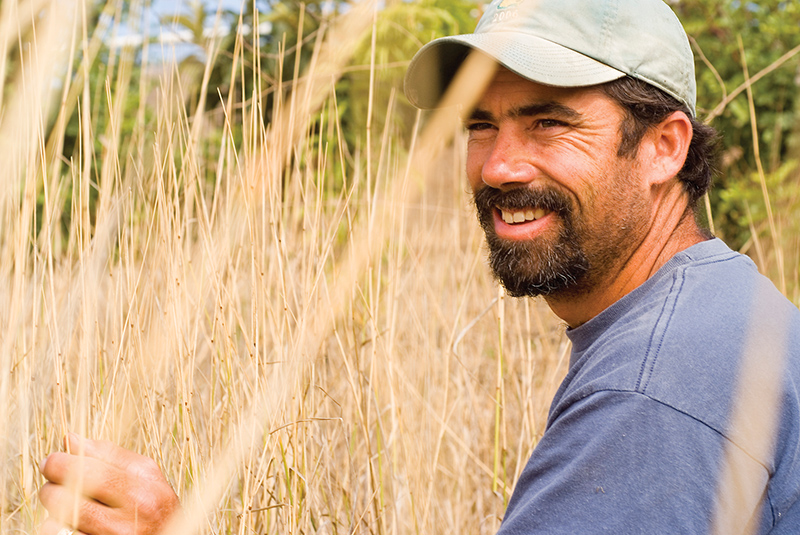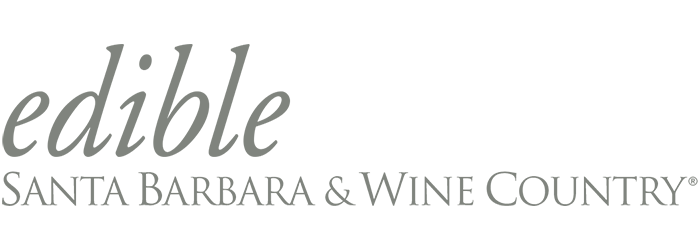Local Grass-Fed Beef: Converting Sunlight to Food
[Photography by Fran Collin]
I’ve often seen the cattle grazing on our hillsides, but never really connected that to the history of our community or even to the meat I buy at the grocery store. When I started seeing local grass-fed meat at the farmers market, I wondered why anyone would spend that much for a pound of ground beef or a grass-fed steak. Was it the flavor, tenderness or the fact that the cows have been allowed to feed on organic grasses and not been given hormones or antibiotics?
I set out to learn more about these cows by interviewing three of our local cattle ranchers, but I actually learned more about grass, soil and community. Grazing cattle play an important role in converting the sun’s energy into food. Not only do they provide meat, but they also nourish the soil and the community of microbes and fungi that make plants healthy and nutritious. The food chain is a community of interactive participants, including plants, cows and humans.
Elizabeth Poett
Rancho San Julian Beef
I turned off the 101 Freeway onto Highway 1 toward Lompoc and drove alongside the 13,000-acre Rancho San Julian for many miles before I reached the entrance.
Comandante José de la Guerra established this cattle ranch in 1817 to provide meat for the Presidio of Santa Barbara. Spain granted title of the ranch to Comandante de la Guerra in 1837. His descendants still share ownership of the ranch.
Elizabeth met me in front of the large white adobe built by her ancestors. She is the sixth generation to live on this ranch. We crossed the dirt road (once the main road to Santa Barbara) to have iced coffee on the porch of the old bunkhouse that is now her home. We were joined by two border collies, an Australian shepherd and one dog of undetermined lineage. A cat rubbed against my leg and then hopped up onto my lap. This is clearly a family ranch, not a factory farm.
Elizabeth said she’d drive me out to the pasture later to see the cows in their natural habitat. She told me about a steer named Pepper she has found sitting on the grass in the morning with her dogs. She helped to deliver him and bottle-fed him after his mom had some trouble. The dogs find the whole thing a bit embarrassing, she says, and Pepper won’t let her pet him in front of the other cows, but that’s life on this cattle ranch.
Elizabeth’s dad, Jim Poett, moved his family to the ranch 30 years ago, right before Elizabeth was born. He began raising organic beef in the 1980s, selling quarters to local markets and butcher shops. One of the first organic beef producers, he helped write the California Organic Food Act. Then he stopped selling his beef commercially in the 1990s to improve the genetics of his herd and further develop the ranch’s environmental infrastructure.
Meanwhile, Elizabeth left for Kenyon College in Ohio to study Spanish history. After college she moved to New York and then Los Angeles, but she was spending most weekends at the ranch working with her dad. She moved back to the ranch about 4½ years ago to help develop new markets for his beef.
Elizabeth missed ranch life and the generations of tradition shared with other ranchers. For example, she explains, “In the early spring, we gather the cattle for branding. Sometimes we’ll have 20 people come from other ranches to help us. And we go to their brandings. Everybody helps everybody.”
Elizabeth met her husband, Austin Campbell, at a branding. Most of the year the three of them can handle the workload themselves, but when they need extra help or experienced advice, they know they can ask their neighbors.
She adds, “The amount of work it takes to create food is humbling, and we want to be environmentally sustainable as well as productive. Most of our feed is dry farmed, and the areas the cattle graze are not irrigated. We have some natural springs but water here is precious.”
That’s why not all her beef is 100% grass-fed. She explains, “I harvest my 100% grass-fed once a year. Since I don’t irrigate, I do it when the grass is the strongest.” During dry periods she feeds the remaining cows dried oat hay, alfalfa and barley, but no corn.
Some larger cattle operations feed their cattle corn to fatten them more quickly, but cows are not biologically suited to eat corn, which can cause painful acidosis. Antibiotics are usually included in their feed to prevent ulcer-caused infections.
No antibiotics or hormones are given to steers raised for the Rancho San Julian Beef program. Healthy cows don’t need them, and there is growing concern at the FDA that our constant use of antibiotics is fueling the growth of antibiotic-resistant infections.
At this point we all (dogs too) jumped into the truck to go out in search of grazing cattle. The property is divided into five ranches, with multiple pastures per ranch. Four-wheel drive is a must if you are searching for cattle. We drove through a grove of California live oaks, past grazing deer, and spotted four cows on their way to somewhere shady. The sun was hot as we headed out onto the narrow road hugging a hillside covered in golden native grass.
“All of our cattle are born and raised here. They are out on the hillsides their entire lives.” The cows are rotated from pasture to pasture to allow grazed areas to recover. “We dry farm additional oat hay here to use with alfalfa and barley grown by other local farmers when we need to supplement the native grass.”
I tried not to look down as we climbed higher along the dirt road toward the crest of the hill. I was glad Elizabeth was driving and seemed confident. In addition to deer, the ranch is home to coyotes and mountain lions and there are indications that a bear is living here as well.
At the crest of the hill we stopped. We could see out to the ocean, back to Santa Ynez and over to Lompoc … and there were no cows. Elizabeth assured me that 500 head of cattle were grazing somewhere, just not right here at this moment. The heat of the day drives them into shadier nooks and crannies. “We want them to live like cattle should live. Walk up the hill, walk down the hill, over that hill, that’s fine.”
It didn’t matter, the view was breathtaking. This is the life of a humanely raised cow, as it was 175 years ago on this ranch—grazing in the sunshine, being nourished by native grasses and nourishing the soil that grows these grasses.

John and Nadine de Bruin
Dey Dey’s Best Beef Ever
I stood at the top of another hill with John de Bruin looking out across the Santa Rita Hills located between Buellton and Lompoc. This area is greener than Rancho San Julian this time of year. It’s part of a 100-square-mile wine-growing appellation known for excellent Pinot Noirs and Chardonnays. Intersected by the Santa Ynez River, the climate here is cooler. As we overlook the valley below, John points out Dierberg, a neighboring vineyard. “Wouldn’t this be a great place to put a house?” he says. “I just love this view.”
John brought his brother to the ranch right after he bought the 168-acre parcel in 2003. John says, “My brother looked at me and said, ‘What the heck are you doing? This will be an 18- to 20-hour-a-day job!’” John laughs. “But I’m in heaven; this is the stuff I want to do. If I can live out the rest of my life here I’ll be very happy.”
His wife and childhood sweetheart, Nadine, was a little harder to convince. However, you’d never guess that today when you meet her at the farmers market. John explains, “This wasn’t exactly her idea of retirement!” I sort of understood, because he told me this story as we were driving sideways through a large pool of mud.
They looked at land in Montana and Idaho, but their two children and five grandchildren live in Santa Barbara. He says, “Nadine and I realized that if we bought land there, we’d either be visiting our ranch twice a year or visiting our kids twice a year.” Ask John about his grandchildren and you’ll know why he is here. (“Dey Dey” is the nickname given to him by his grandchildren.)
So John has chosen to prove that a small cattle farmer can be successful right here in Santa Barbara. John is quick to point out that his job is to grow strong, rich grasses and lead his cattle to them. He also keeps meticulous records of each cow to learn what works and what doesn’t. He practices management intensive grazing and raises Lowline (small) Angus cows and crosses. His goal is to develop great-tasting beef raised in a healthy environment.
John says, “I spent two summers on a dairy farm in Holland where I learned two things: 1) I love cows, and 2) I don’t want to be a dairyman.” John’s parents emigrated from Holland to Venezuela just before he was born. His family immigrated to Southern California when he was 10. John got a master’s degree at the University of Wyoming in physics and then worked as an aerospace engineer. He came to work at Santa Barbara Research Center in 1985, building satellite sensor systems. He says, “I thought cattle ranching would be a piece of cake, but it turns out it’s quite a complex business.”
He bought the ranch from William Brown, a rancher who raised hay and had 14 head of cattle. Now John has close to 150 head of cattle. Navigating another mud puddle, John pointed and said, “That little R2D2-looking thing is the pride and joy of this ranch. It controls the water from our well—pure delicious ground water.”
“One of the things that sets us apart from other California ranches is that we have water, so we can grow specific green grasses for good gains and good-tasting beef—alfalfa, perennial rye, orchard grass, fescues and brome during dry periods when the native grasses dry out.”
Working alongside John on the ranch is Crystal Murray, herd manager, who monitors and maintains the health of the herd. Logan Vale manages the chickens. We drive over to another pasture to meet Logan and see high intensity low duration grazing in process. “This is our feedlot,” says John as he helps Logan move a portable chicken coop onto an area grazed recently by the herd of heifers and calves grazing nearby. The chickens quickly get to work digging through cow manure to find bugs and fly larvae.
The chickens not only vacuum up the bugs and control the fly population, but their scratching works the cow patties into the ground to feed the grass. They also leave their own fertilizer donation. “The soil becomes rich with no chemical fertilization. In just five or six years you see amazing improvement in the
soil quality.”
Logan adds, “Grass takes carbon dioxide from the air. The cows eat the grass and their manure helps keep the carbon stored in the ground. For me, that’s the biggest reason to be a grass farmer. You’re doing something positive for the environment on a personal level.”
“To grow healthy grass, all you add is water and an animal,” John says as we prepare to move the cattle to a fresh paddock. In 24 hours the grazed area is down to about two to three inches. One thing that makes intensive grazing possible is portable electric fencing. When Logan disconnects the fence and begins to roll up the wire, the cows rush into the new paddock, mooing with excitement.
John explains how cows process the energy from the sun, captured by grasses humans can’t digest. “Cows, goats, sheep and alpacas are ruminants. They have the unique ability to process the cellulose in grass and get the nutrients from of it. They fill up the rumen (their first stomach), which is basically a fermentation pot containing lots of enzymes and bacteria. It sits there until they regurgitate it. They chew that up, masticate and swallow it back down. They’re like four-legged combines that process grass and turn it into delicious-tasting beef.”
John and Nadine’s beef cows and chickens are never fed hormones or antibiotics. Their beef cows are never fed grains or corn. (Editor’s Note: John and Nadine have now retired, so Dey Dey’s Beef is no longer available.)

Guner Tautrim
Orella Ranch
On a clear day you can see out across the ocean to the Channel Islands from Guner’s outdoor deck at Orella Ranch. I was there recently with a group of Sol Food Festival volunteers and organizers to share dinner and ideas for the event. Guner feels strongly about the role of community in helping to rebuild healthy food systems.
Guner’s great-great-great-grandfather Bruno Orella purchased what is now the Orella Ranch from the Ortega land grant along the Gaviota coast in 1866. The ownership was gradually divided up among Orella’s descendants. Guner’s father, Mark Tautrim, owns this 300-acre piece with the ocean view. Guner was born and raised on the ranch. His children, Sequoia and Kai, are the seventh generation to live on the ranch.
When Guner was young, his father and grandfather ran a traditional cow-calf operation with about 120 head of cattle. Later his father took a job in town and leased out the land to various cattlemen.
Guner left the ranch to attend Humboldt State University, where he majored in sustainable ecological tourism with a minor in Pacific Island studies. After graduating, Guner spent 2½ years sailing around the Pacific looking for a place that still had its cultural integrity and environmental beauty intact so he could help the local people realize, appreciate and protect what they had.
Guner returned to Gaviota with his wife, Heidi, about nine years ago and realized that the magical place he was looking for was right here. He says, “Gaviota was under the threat of development. Almost everything along the coast from the Mexican border to the Bacara had been developed, right up to the Goleta urban limit line. I didn’t need to be on a Pacific Island in the middle of nowhere, I needed to be here fighting for the protection of our ranch. The Pacific Islands are right in my front yard—Santa Cruz, Santa Rosa and San Miguel.”
Studying their options, while realizing the family might need to take a different direction to make the land sustainable, they decided to eliminate the cattle operation and educate themselves about stewardship of the land. Guner formed the Orella Stewardship Institute and began bringing in experts in water and soil management to give classes for local farmers.
In the past five years, Guner’s attitude toward cattle has changed. He says, “Being an environmentalist coming out of college, I thought cattle were evil because they cause erosion and degrade the land. But it’s the management of them that causes the degradation, not the cattle themselves.
In the long term plan for Orella, cattle will play an integral part. Guner explains, “There’s no healthy grassland in the world that’s void of impact from herbivores.” In nature, large herds move quickly to new areas, chased by predators, so you get high stock density in one area for a short time and then a long recovery period. As the herd moves, it roughs up and fertilizes the soil.
In nature, birds follow the herds to eat bugs that grow in the cow patties. Guner says, “So we bring in chickens to follow the cows.” Chickens sanitize the fields so we don’t need to feed antibiotics and deworming agents to our cows.” Guner points out that the dung beetles that once played a large role in integrating manure into the soil are almost completely extinct in the United States. “They are dying from what we inject into our cattle.”
So the plan for the ranch is threefold: 1) Manage the rainfall to maximize its use; 2) develop humus that contains a healthy community of microbes and mycorrhizal fungi that symbiotically draw liquid carbon out of plant roots in exchange for plant nutrients (the deeper and richer the soil, the more carbon sequestration); and 3) relocalize.
Guner explains that re-localization is the part we (the larger community) can play in the land stewardship story. He says, “Traditional cattlemen say there’s no money in cattle, but that’s because they sell to the commodity beef industry. They sell their cattle to feed lots to be fattened, slaughtered and shipped around the world. If cattlemen in Santa Barbara County processed their beef locally and sold it locally, to restaurants, farmers market customers and buyer’s clubs, there would again be money in the cattle business.”
He adds, “When I talk about the importance of land stewardship, people say, ‘But I don’t have 300 acres.’ I tell them, ‘Support the people that do—support their land stewardship. Vote with your dollar.’”
Keep an eye on Orella Ranch for updates on their offerings.






